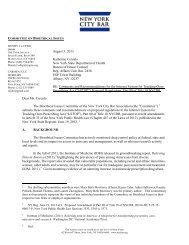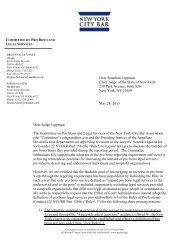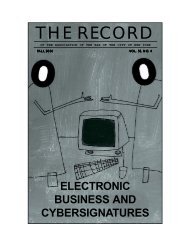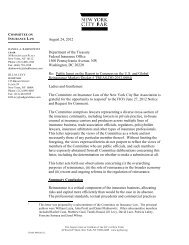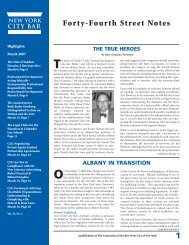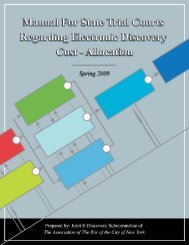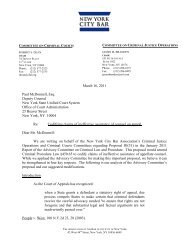2007 Issue 1 - New York City Bar Association
2007 Issue 1 - New York City Bar Association
2007 Issue 1 - New York City Bar Association
You also want an ePaper? Increase the reach of your titles
YUMPU automatically turns print PDFs into web optimized ePapers that Google loves.
J U D I C I A L S E L E C T I O N T A S K F O R C E<br />
are primary elections to the nomination of the most qualified candidates.<br />
This is not simply because a party organization could—as has the <strong>New</strong><br />
<strong>York</strong> County Democratic Committee since 1977—adopt party rules requiring<br />
the county organization to support only those candidates rated most qualified<br />
by an independent screening commission. 51 Plainly, an enlightened<br />
party organization could adopt similar rules whether the candidates were<br />
vying for nomination at a convention or primary election. Rather, the convention<br />
system is more amenable to selecting qualified candidates because the size of<br />
the audience who must consider those qualifications is drastically smaller.<br />
A candidate for nomination at a primary election who proudly bears<br />
a “most qualified” rating from an independent screening commission must<br />
still bear the cost of educating a vast number of potential voters about<br />
the significance and importance of such a rating. Even then the importance<br />
of that rating must stand out in a veritable stew of political considerations<br />
that often overwhelm the solitary voice of an independent screening<br />
commission. On the other hand, when the audience is comprised of a<br />
relatively small number of candidates for delegates, or delegates who have<br />
been elected, at a convention, a “most qualified” rating from an independent<br />
screening commission can be a much more significant, and indeed<br />
potentially decisive, factor. 52 For this reason, we are recommending<br />
conventions held in small districts from which delegates are elected, leading<br />
to many more conventions, with a maximum of 15 delegates at each<br />
convention. This will substantially increase the ability of qualified “outsider”<br />
candidates to have a realistic chance of nomination.<br />
Finally, we believe that a reformed judicial convention system has<br />
the potential to promote greater diversity among candidates for Supreme<br />
Court nomination than does an open primary. As the District Court found,<br />
this is not an inherent advantage to the convention mechanism. We recognize<br />
that other means of promoting diversity on the Supreme Court<br />
bench are available, including the use of cumulative voting in primary<br />
elections and the creation of judicial districts involving geographically<br />
compact minority populations. 53 But for reasons discussed earlier, a re-<br />
51. Both the Task Force 2003 Report and this Report strongly recommend the establishment<br />
of screening commissions in the context of a reformed convention system. See Task Force<br />
2003 Report at 32-35; infra Section IIB.<br />
52. The Task Force recommends that a body governing and overseeing all qualification<br />
commissions set the standards of the evaluation of judicial candidates. See infra Section IIB.<br />
For the process by which the <strong>Association</strong> evaluates candidates for elective and appointive<br />
judgeships, see Task Force 2003 Report at 16-17.<br />
53. Lopez Torres, 411 F. Supp. 2d at 252.<br />
T H E R E C O R D<br />
110



